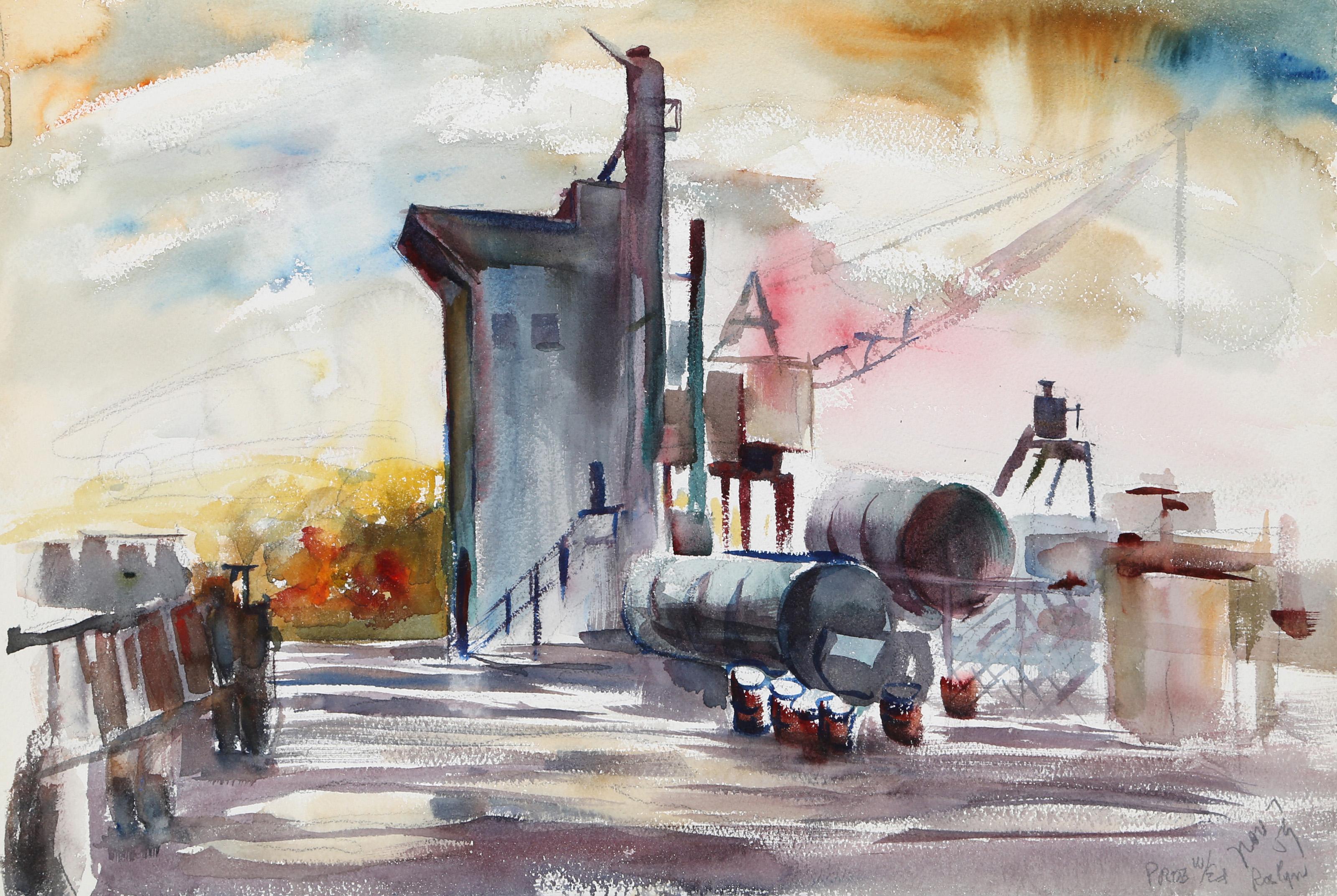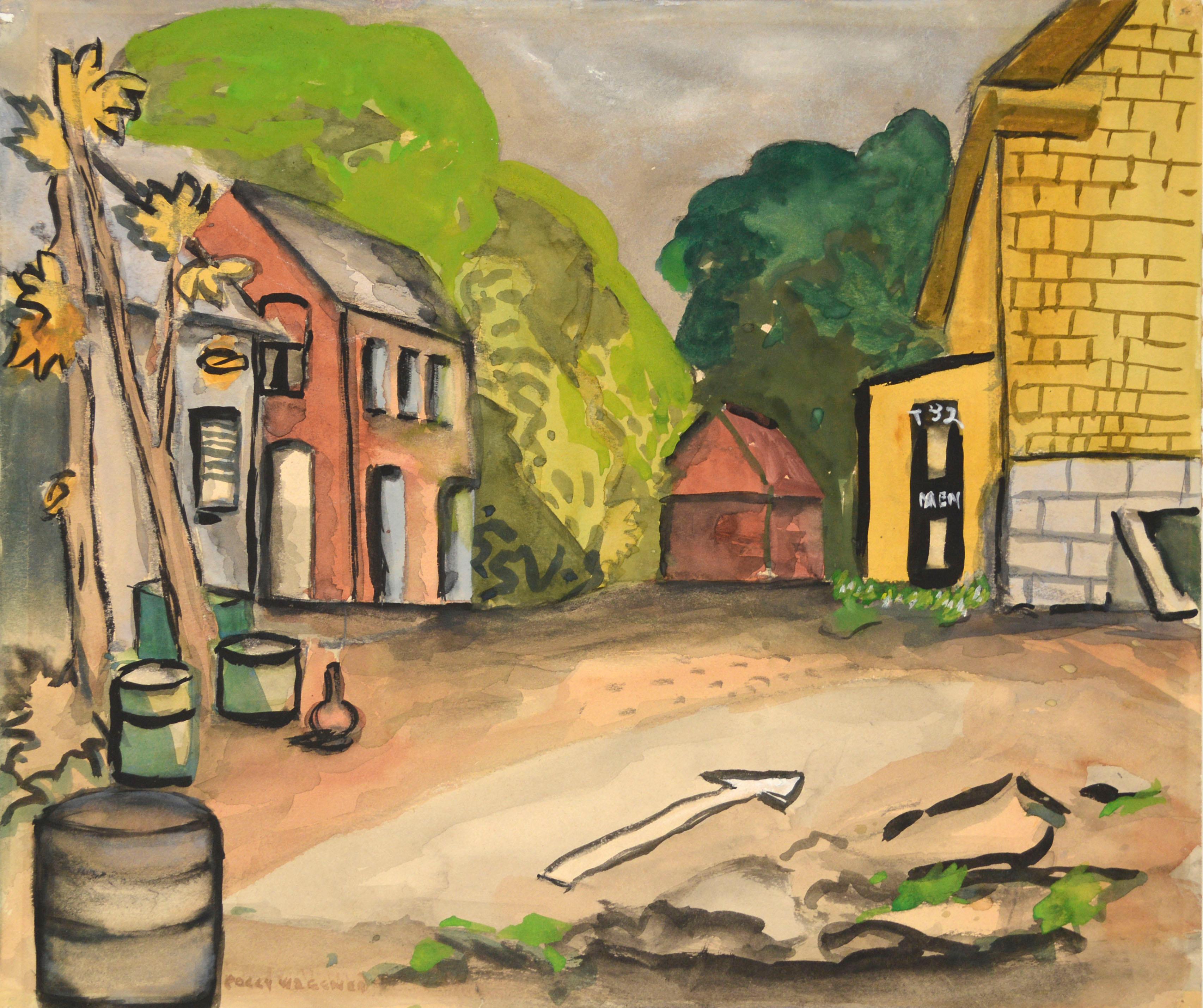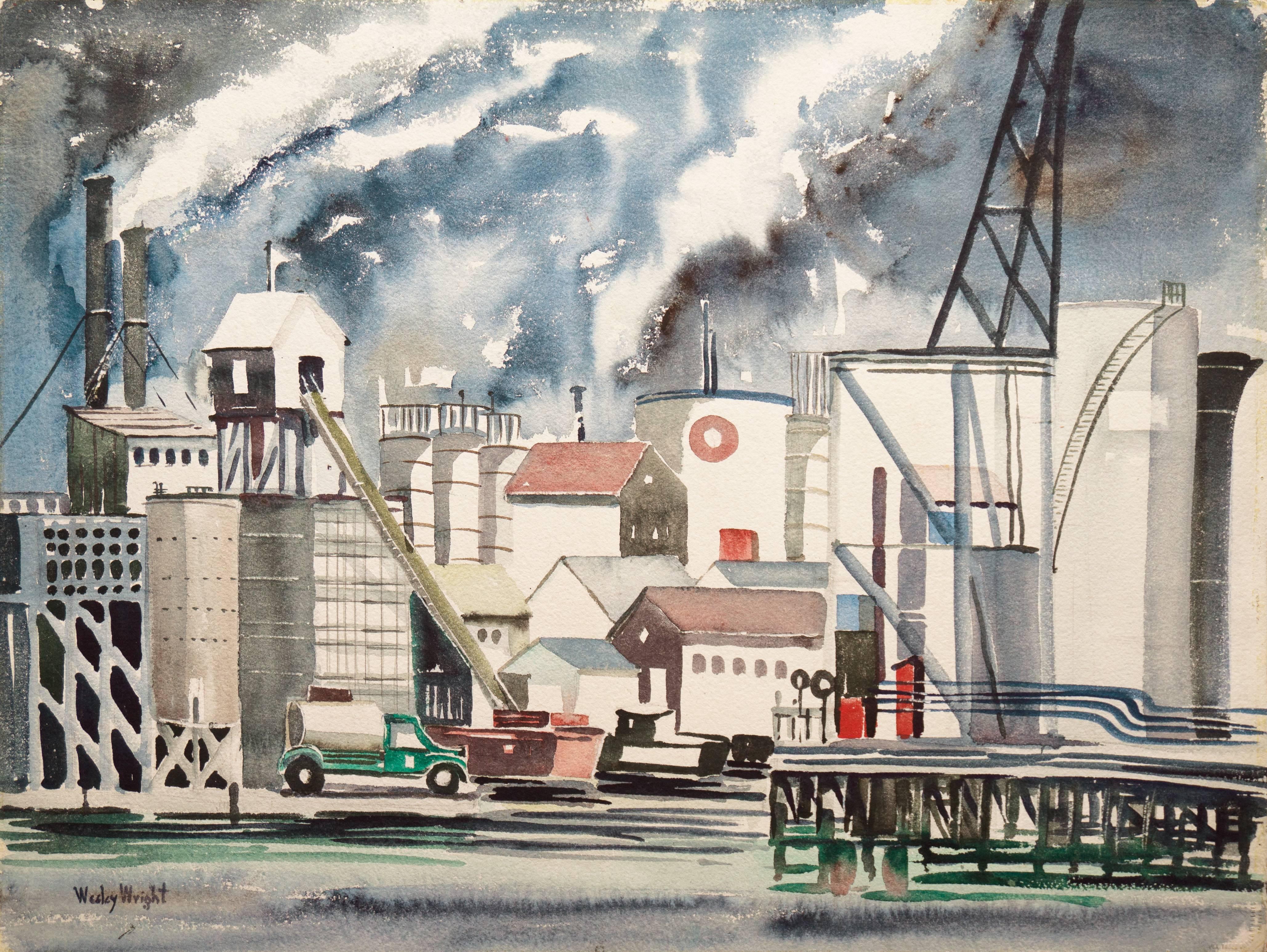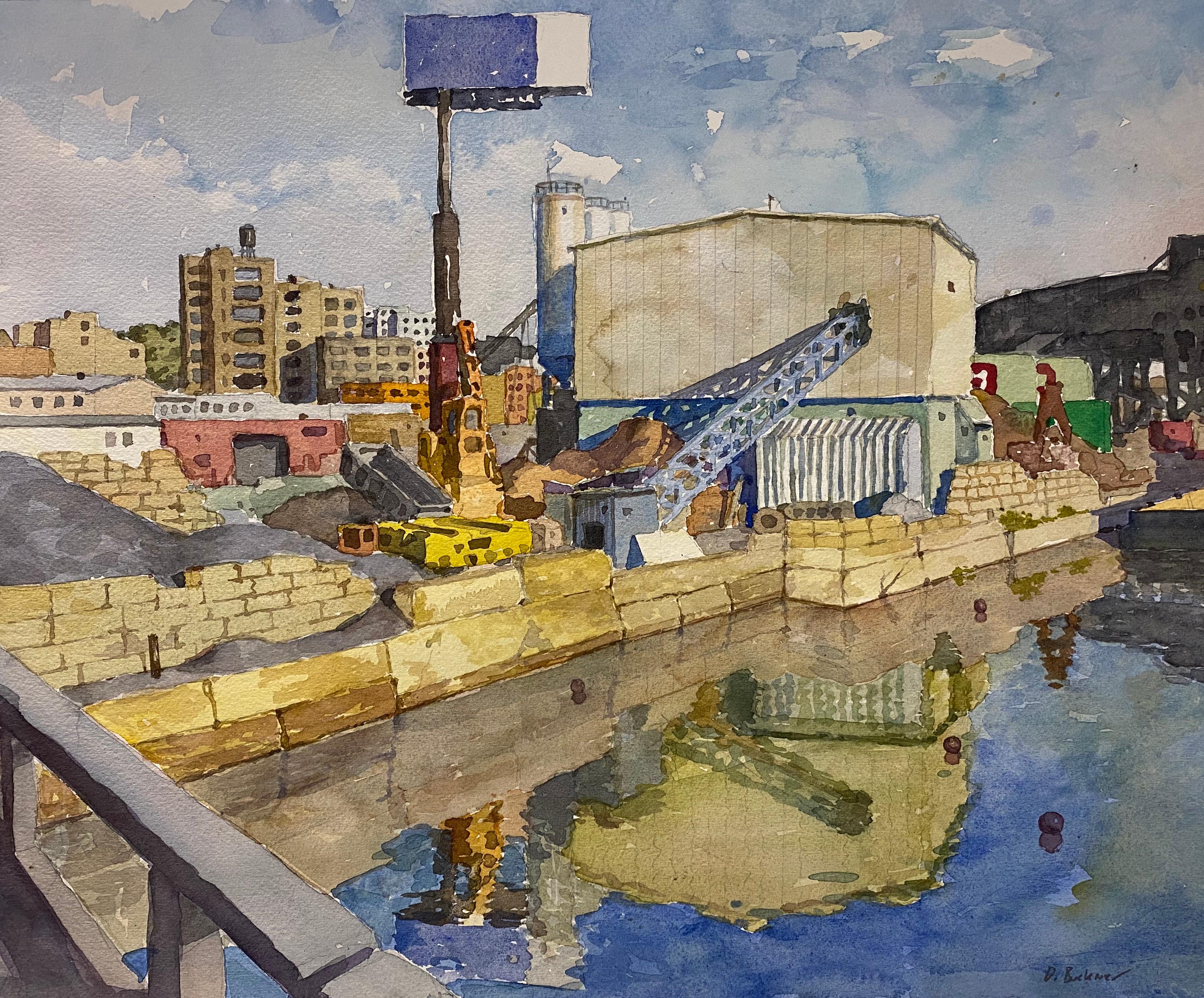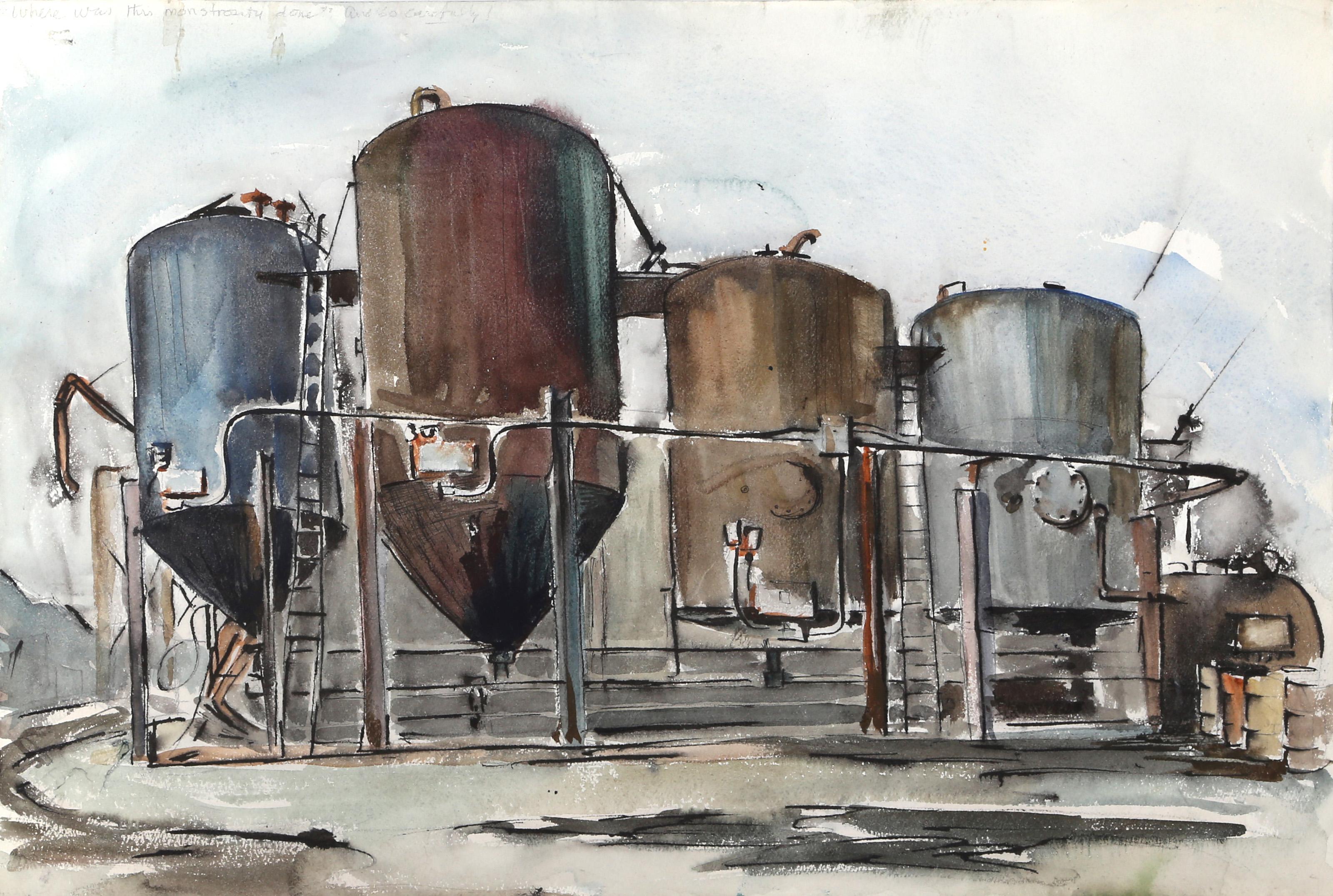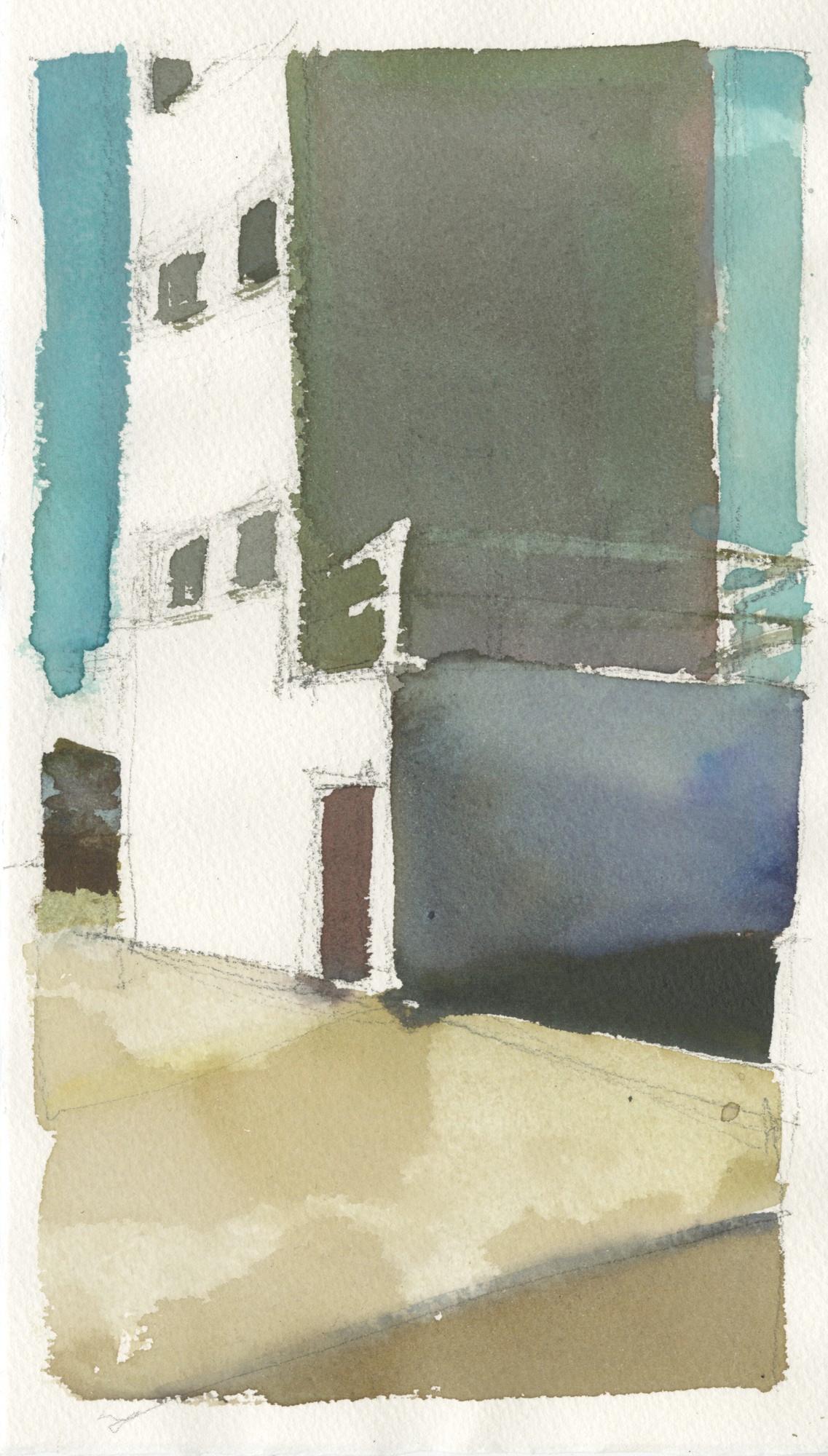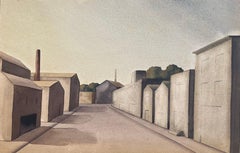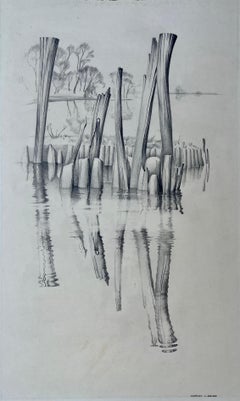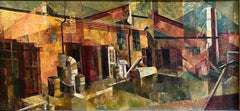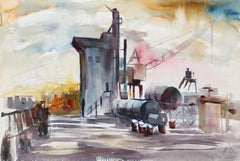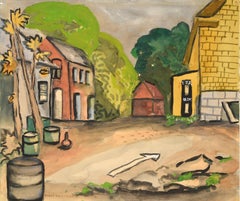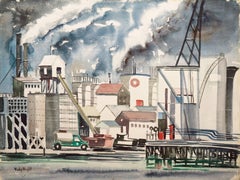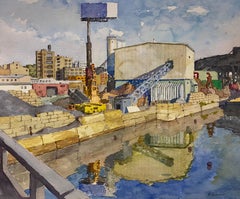Items Similar to Oil Tanks, Alameda Street, Los Angeles
Want more images or videos?
Request additional images or videos from the seller
1 of 5
Ruth ZimmermanOil Tanks, Alameda Street, Los Angelesc. 1930 - 1933
c. 1930 - 1933
$850
£648.97
€749.88
CA$1,193.24
A$1,329.99
CHF 697.80
MX$16,241.34
NOK 8,835.66
SEK 8,351.04
DKK 5,596.68
About the Item
Oil Tanks, Alameda Street, Los Angeles, c. 1930-33, watercolor on paper, 14 ¼ x 21 ¼ inches (image), inscribed verso: “watercolor by Ruth Zimmerman 1912 – 1968 / Practice work for school (LA City College or Chouinards L.A.) about 1930 – 33 / Storage Tanks near Alameda Street, Los Angeles”
Ruth K. Zimmerman was born in Los Angeles on October 2, 1912, to Caroline Lisette Fritz and Frederick Martin Zimmerman. She graduated from Hollywood High School in 1930 after focusing her efforts on art and music. Zimmerman then studied art for two years at Los Angeles Junior College where she contributed costume designs for theater productions and at the Chouinard Art Institute. She continued to live in Los Angeles during the Depression Era and in 1937 married fellow artist and schoolmate from Hollywood High School, Conrad C. Capune. He was a member of the Los Angeles Art Directors Club and made a living as a commercial artist, including working on the periphery of the film business. The 1940 census lists Zimmerman as a freelance artist, earning $500 income in 1939. In 1942, Zimmerman gave birth to a son, Laurence Conrad Capune. Zimmerman and Capune divorced sometime in the mid-1940s. After that time, it appears Zimmerman's artistic output decreased. In 1947, she remarried Dr. David Fink (1894 – 1968), a prominent Southern California psychiatrist. By 1950, Zimmerman was working as a clinical psychologist in her husband’s medical practice. After suffering from serious illnesses, Fink and Zimmerman took their own lives in 1968. Zimmerman was only fifty-six years old.
- Creator:Ruth Zimmerman (1912 - 1968, American)
- Creation Year:c. 1930 - 1933
- Dimensions:Height: 14.25 in (36.2 cm)Width: 21.25 in (53.98 cm)
- Medium:
- Movement & Style:
- Period:
- Condition:
- Gallery Location:Los Angeles, CA
- Reference Number:1stDibs: LU1859216266492
About the Seller
5.0
Vetted Professional Seller
Every seller passes strict standards for authenticity and reliability
1stDibs seller since 2022
15 sales on 1stDibs
Typical response time: <1 hour
- ShippingRetrieving quote...Shipping from: Los Angeles, CA
- Return Policy
Authenticity Guarantee
In the unlikely event there’s an issue with an item’s authenticity, contact us within 1 year for a full refund. DetailsMoney-Back Guarantee
If your item is not as described, is damaged in transit, or does not arrive, contact us within 7 days for a full refund. Details24-Hour Cancellation
You have a 24-hour grace period in which to reconsider your purchase, with no questions asked.Vetted Professional Sellers
Our world-class sellers must adhere to strict standards for service and quality, maintaining the integrity of our listings.Price-Match Guarantee
If you find that a seller listed the same item for a lower price elsewhere, we’ll match it.Trusted Global Delivery
Our best-in-class carrier network provides specialized shipping options worldwide, including custom delivery.More From This Seller
View AllUntitled (Industrial Street)
Located in Los Angeles, CA
This work is part of our exhibition - America Coast to Coast: Artists of the 1940s
Untitled (Industrial Street), c. 1940s, watercolor on paper mounted on illustration board, estate stamp verso (signed by Peter Corbridge, the artist’s son); 14 x 21 inches; unframed
Edgar Corbridge was a Massachusetts-based precisionist painter who mainly worked in watercolor. In 1916, three years after immigrating from England, Corbridge completed a course of study in sign painting at the Fall River, Massachusetts Technical High School and obtained an apprenticeship with the Armour Sign Shop. Throughout his career, Corbridge was mainly self-taught as a fine artist. In 1918, Corbridge received his first recognition as an artist for his entry in a Fall River Women’s Club poster competition. During much of his professional life, Corbridge worked as a self-employed window trimmer and operator of the Corbridge Display Service, supplemented by income from the occasional sale of his paintings. Corbridge gleaned the subjects for his works in and around his home in Fall River, Massachusetts, as well as Provincetown. In the 1940s, Corbridge began to exhibit frequently, including at the annual exhibitions at the Jordan Marsh Company...
Category
1940s American Modern Drawings and Watercolor Paintings
Materials
Watercolor, Board
Abandoned Wharf
Located in Los Angeles, CA
This drawing is part of our exhibition Charles Goeller: A Wistful Loneliness.
Crayon on paper, 20 x 12 (image), 22 x 14 inches (sheet), Signed lower right, Matted, but not framed
Ex...
Category
1940s American Modern Landscape Drawings and Watercolors
Materials
Crayon, Paper
Three Chimneys
Located in Los Angeles, CA
Three Chimneys, 1956, oil on Masonite, signed and dated lower left, 18 x 36 inches, titled verso, presented in its original frame
Three Chimneys is a prime example of Ethel Margolies’ Precisionist-influenced industrial scenes. Throughout the 1950s and 1960s, Margolies made a name for herself by painting the Northeast’s factories, foundries, and manufacturing plants. Although this subject matter is often associated with male artists, Margolies is part of an important lineage of female modernists who depicted symbols of America’s industrial might. Starting with artists like New Jersey’s Elsie Driggs and Chicago’s Yvonne Deluc Pryor, Margolies is part of a through line of women Precisionist painters that also included the West Coast’s Vanessa Helder. Whereas these artists tended towards a stark and pristine realism, Margolies seems to have been influenced by the 1920s and early 1930s work of Charles Demuth’s and Charles Sheeler’s highly designed paintings from the same period, as both adopted a cubo-futurist oriented brand of Precisionism.
Ethel Polacheck Margolies was a Connecticut painter...
Category
1950s American Modern Landscape Paintings
Materials
Masonite, Oil
Moonlight Shanties
Located in Los Angeles, CA
Moonlight Shanties, c. 1940s, oil on canvas, 24 x 18 inches, signed lower right, signed and titled verso
About the Painting
In Moonlight Shanties, Joachim depicts a lower-class neighborhood sitting along-side an elevated road or railway which crowds out the small nearby houses and structures. Joachim’s use of an expressionist palette and gestural brushstrokes together with the isolated figures obscured in the shadows, create a feeling of unease, isolation and even loneliness. From the 1920s through 1940s, American artists commonly employed expressionist conventions in their social realist works which portrayed the gritty side of urban America, especially the communities of the city-dwelling poor. Expressionist styles were considered appropriate for bridging the gap between the modernist idea of art-for-art’s-sake and the narrative qualities demanded by the dual crises of the Great Depression and World War II. Moonlight Shanties successfully uses these expressionist methods to portray a neighborhood and its people who appear to be literally and figuratively “on the edge.”
About the Artist
Paul Lamar Joachim...
Category
1940s American Modern Landscape Paintings
Materials
Oil
Factory Worker
Located in Los Angeles, CA
This painting is part of our exhibition America Coast to Coast: Artists of the 1930s
Factory Worker, c. 1936, oil on canvas, signed lower right, 18 ¼ x 36 inches; exhibited in City ...
Category
1930s American Realist Figurative Paintings
Materials
Oil
The Railway Station
Located in Los Angeles, CA
The Railway Station, c. 1934, oil on canvas, signed lower right, titled verso and noted "34"; illustrated Kaufman, Jeffrey, Brush with Life: The Art of Being Edward Biberman...
Category
1930s American Modern Landscape Paintings
Materials
Oil
You May Also Like
Oil Refinery, Impressionist Watercolor by Eve Nethercott
By Eve Nethercott
Located in Long Island City, NY
Eve Nethercott, American (1925 - 2015) - Oil Refinery (P1.12), Year: 1959, Medium: Watercolor on Paper, Size: 15 x 22 in. (38.1 x 55.88 cm), Description: Eve Nethercott's abi...
Category
1950s Impressionist Landscape Drawings and Watercolors
Materials
Watercolor
Mid Century Oakland Industrial Landscape Watercolor
Located in Soquel, CA
Mid-century Bay Area urban landscape watercolor of an industrial neighborhood in Oakland by California artist Polly Hughett Wagener (American, 1908–1992). This industrial scene of a ...
Category
1960s Modern Landscape Drawings and Watercolors
Materials
Paper, Watercolor
'Industrial Landscape'
By Wesley Wright
Located in Santa Cruz, CA
Signed lower left, "Wesley Wright", and painted circa 1960.
A substantial, mid-century watercolor view of an industrial area with grain containers and smokestacks.
Category
1950s American Modern Landscape Drawings and Watercolors
Materials
Paper, Watercolor
$617 Sale Price
35% Off
Cement Factory, Gowanus Canal
By Derek Buckner
Located in Fairfield, CT
Derek Buckner is represented by George Billis Gallery NYC and LA. Born in 1970, Derek Buckner lives in Brooklyn, NY, with his wife, novelist Joanna Hershon, their twin sons and daughter. The artist graduated from LaGuardia High School of Music and Art, as well as Vassar College, The Art Students League of New York and received a B.F.A. from The School of the Art Institute of Chicago.
During his career, Buckner has discovered many different themes, but the one to which he has most often returned is the urban landscape. In these paintings, he allows the viewer a distinctive look into his everyday surroundings, often including factory rooftops, bridges and the rapidly changing Gowanus Canal...
Category
21st Century and Contemporary American Realist Landscape Drawings and Wa...
Materials
Paper, Watercolor
Drums, Impressionist Watercolor by Eve Nethercott
By Eve Nethercott
Located in Long Island City, NY
Eve Nethercott, American (1925 - 2015) - Drums (P5.43), Year: 1958, Medium: Watercolor on Paper, Size: 15 x 22 in. (38.1 x 55.88 cm), Description: A unique watercolor on pape...
Category
1950s Impressionist Landscape Drawings and Watercolors
Materials
Watercolor
VFD 1, watercolor, California, Industrial building, architecture, fire training
By Ferdinanda Florence
Located in Riverdale, NY
VFD #1 is a watercolor painting of a California industrial site where fire training drills take place. It is 11x8 unframed.
Ferdinanda Florence was born in Washington, DC, and grew...
Category
2010s Contemporary Landscape Drawings and Watercolors
Materials
Watercolor, Archival Paper
More Ways To Browse
Oil Painting Los Angeles
Old California Watercolors
Vintage Hollywood Costume
C Frederick Oil Painting
Depression Era Paintings
Oil Tank
Fredericks Of Hollywood
Laurence Fellows
Tom Wern
Victor Wong
Limited Edition Print New York
Art Free Shipping
Still Life Study
Paintings On The Beach
Tree Of Life
Gallery 25
Artist Proof Print
Nature Photography
